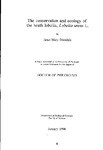The conservation and ecology of the heath lobelia, Lobelia urens L.
| dc.contributor.author | Dinsdale, Janet Mary | |
| dc.contributor.other | School of Biological and Marine Sciences | en_US |
| dc.date.accessioned | 2013-10-29T10:14:07Z | |
| dc.date.available | 2013-10-29T10:14:07Z | |
| dc.date.issued | 1996 | |
| dc.identifier | NOT AVAILABLE | en_US |
| dc.identifier.uri | http://hdl.handle.net/10026.1/2429 | |
| dc.description | Merged with duplicate record 10026.1/801 on 08.20.2017 by CS (TIS) | |
| dc.description.abstract |
This programme of research examines the ecology of the threatened perennial Lobelia urens L. (the heath lobelia) which reaches the northern limit of its distribution in the southern coastal counties of England. A survey of the historical evidence of the distribution of the species in England is presented. Restricted to such a small area, L. urens has always been rare in Britain. The six remaining populations were surveyed to describe the phytosociology of communities containing L. urens and the variability of the environmental factors controlling its distribution. L. urens is shown to be a member of rough grass-heath communities dominated by Molinia caerulea and situated on seasonally waterlogged, moderately acidic, nutrient-poor soils. Studies of the demography of L. urens focused on two extant populations. Experimental research was carried out to support these demographic studies both in the field, on plants grown in a common garden, and under the controlled conditions of the glasshouse and laboratory. This information on the ecology of L. urens was used to construct stage-structured population matrices. Recruitment success in L. urens is shown to be very low in Britain and results suggest that this controls the density of British populations. The availability of seed does not regulate the rate of germination. Instead, recruitment of L. urens at the northern edge of its range is restricted by its specific habitat requirements, along with low summer temperatures and the short growing season. Establishment from seed is facilitated by micro-habitats that provide high light intensities and, more importantly, protection against soil moisture loss. Whilst winter disturbance by herbivores is shown to be essential for successful recruitment, adult growth and survival is better in ungrazed communities. However, even the small plants of the grazed areas are very fecund. The seed forms a large persistent bank that embodies a reserve of individuals and genetic variability which offers protection against extinction. The thesis concludes that the soil moisture status and disturbance regimes at Redlake and Andrew's Wood are limiting the growth rates of the L. urens populations. In order to maintain populations, the redirection of drainage water is prescribed to increase the soil moisture status. L. urens is suited to intermittent soil disturbance, the timing and intensity of which was shown to be important, whilst the duration between grazes was seen to be less critical. Results suggest that the habitat created by occasional heavy winter grazing of fattening cattle would be very favourable to L. urens. | en_US |
| dc.language.iso | en | en_US |
| dc.publisher | University of Plymouth | en_US |
| dc.title | The conservation and ecology of the heath lobelia, Lobelia urens L. | en_US |
| dc.type | Thesis | |
| plymouth.version | Full version | en_US |
| dc.identifier.doi | http://dx.doi.org/10.24382/4856 | |
| dc.identifier.doi | http://dx.doi.org/10.24382/4856 |
Files in this item
This item appears in the following Collection(s)
-
01 Research Theses Main Collection
Research Theses Main


